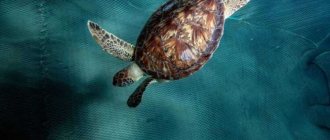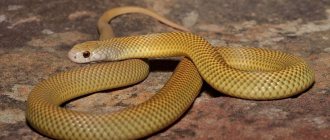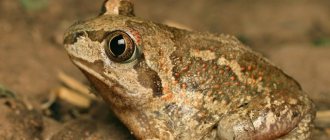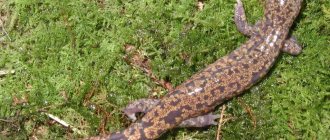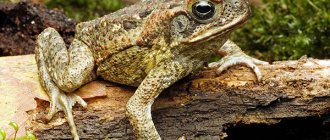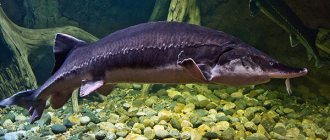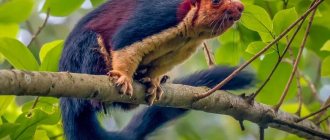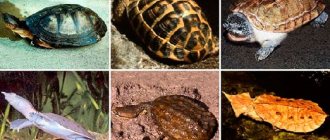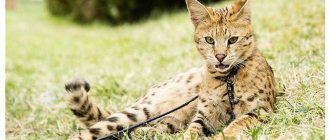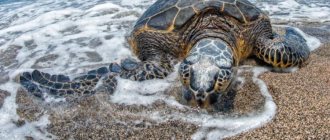- Wild animals
- >>
- Reptiles
The giant tortoise is one of the animal species most commonly associated with the Galapagos Islands. Believed to be descended from turtles from a continent that washed ashore in the Galapagos thousands of years ago, there are now several subspecies endemic to different islands. They can live for over a hundred years and are inextricably linked to the human history of the islands.
Snapping turtle (35 cm)
Adults discovered by pioneers in the Cayman Islands wear a shell up to 35 cm long. Reptiles weigh up to 14 kg. Found in Canada, Central and Eastern states of America. Favorite habitat is the banks of deep, slow-flowing rivers. Turtles burrow into soft bottom sediments for the winter, raking away the mud with their powerful paws. When it gets cold, the giants fall into deep hibernation.
Large predators easily bite small fish with their beak-shaped jaws. They catch them by throwing their long neck out of their shell with lightning speed. If fishing is unsuccessful, they feed on carrion. A massive head with bulging eyes, three ridge-like saw-like processes on the carapace and a rather long tail are characteristic features of the species.
Story
Although often considered examples of island gigantism, before the arrival of Homo sapiens
Giant tortoises have also occurred in non-island areas, as well as on a number of other, more accessible islands.
During the Pleistocene, and mostly during the last 50,000 years, turtles of mainland South Asia ( Megalochelys atlas
), the Americas, Indonesia, Madagascar (
Aldabrachelys
), and even the island of Malta became extinct.
The giant tortoises of Africa went extinct somewhat earlier, during the late Pliocene. While the timing of the extinctions of various species of extinct giant tortoises appears to correlate with the arrival of humans, direct evidence of human involvement in these extinctions is generally lacking; However, such evidence has been obtained in the case of the distantly related giant meiolaniid turtle myolanium damelipi
in Vanuatu.
One interesting relic is the shell of an extinct giant turtle found in a flooded drainage well in Florida with a wooden spear piercing it, carbon dating from 12,000 years ago. Today, only one of the Indian Ocean species survives in the wild; Aldabra giant tortoises (more than two are claimed to exist in captive or re-released populations, but some genetic studies have questioned the validity of them as separate species) and 10 extant species in the Galapagos.
Red-eared slider (37 cm)
The freshwater red-eared turtle is ranked ninth in the ranking of the largest turtles in the world. Females of this species reach 37 cm in their shell by adulthood. Males are much smaller - up to 20 cm long. Omnivorous reptiles adapt well in captivity. Officially, up to 52 million turtles are sold per year. Individuals can live in apartment aquariums for up to half a century. They are born small, no more than 3 cm. They grow by 5 cm per year.
Turtles are valued for their decorative properties: variegated colors in greenish and olive tones, red spots on the sides of the head. They are inactive - they can not change positions for a long time. In nature, reptiles prefer swampy bodies of water. They can be found on the American continents, Southeast Asia, warm European countries, Africa and Australia. They displace other species of turtles from their habitat.
Types of turtles
The long stay of representatives of this order on the planet allowed them to divide into 328 species, differing in external characteristics, size, habitat, nutrition and lifestyle.
The classification involves the division of reptiles, depending on how they hide their heads in the shell, into cryptonecks and side-necks. The first group presses their head into the shell by contracting the neck muscles. The second is folded to the side, under one of the front paws.
Another classification is based on the habitat of these reptiles:
- sea turtle - lives in the salty waters of the seas and oceans;
- terrestrial - capable of living both on the surface of the earth and in fresh waters; this variety, in turn, is divided into freshwater and land.
Green turtle
This sea turtle chose the waters of the Atlantic, Pacific and even Indian oceans for its life.
There are two subspecies of these reptiles: Atlantic and eastern Pacific. Its elongated shell can be not only green, but also dark brown with yellow and white stripes or spots.
Reptiles got their name not from their external coloring, but from the color of the meat they ate.
The green turtle is one of the largest species. The length of its shell can reach up to 2 m, and its weight can reach 400 kg.
Young individuals live exclusively in water, where they feed on small fish, mollusks, and jellyfish. Adult reptiles come ashore, where they begin to feed on plant foods, which over time become their main diet.
The tasty meat of these animals was traditionally used for food (they are even called soup animals), which led to a decline in the population. Hunting them is currently prohibited in many countries.
The onset of puberty occurs after 10 years, sometimes much later. Reptiles mate in water, but lay their clutches on the shore, in the same places where their predecessors laid eggs. They dig very large holes in which they place up to 200 eggs. Small turtles, hatching, run towards the water. If they managed to get there, they will spend many years in the ocean, until the moment comes when they themselves have to go ashore to give birth.
If your pet is a sea turtle, keep in mind that caring for it at home is much more difficult than for land-based ones, since you need to have spacious aquariums with water adapted for the reptile.
Far Eastern turtle
Another name for this species is Chinese trionix, or Chinese tortoise. The Far Eastern turtle prefers to live on the silt-covered bottom of large lakes and rivers with gently sloping overgrown banks. Their habitat is Primorye, the southern part of the Amur in Russia, Vietnam, China, Japan, Korea and Taiwan.
The Far Eastern turtle is green-brown or green-gray in color with pale yellowish spots. Its usual size is about 30 cm, but there have been specimens up to 40 cm and weighing more than 4 kilograms. They have fleshy lips covering strong jaws.
The shell of these animals in young individuals has a rounded shape. It becomes flatter with age. A distinctive feature of young individuals is their bright orange abdomen, the color of which becomes pale over time.
The Chinese turtle is capable of hunting both in water and on land, where it goes out to bask in the sun. These reptiles hibernate by burying themselves in the mud.
The diet of these predatory reptiles consists of fish, shellfish, amphibians and insects. The Far Eastern turtle can guard its prey for a long time by burying itself in the mud.
At the age of 6-7 years, the Far Eastern tortoise becomes sexually mature. Usually in July they lay eggs at a short distance from the water. During the season, the female makes several clutches, from which about 70 turtles emerge. After 1.5 - 2 months, babies appear, the size of which is no more than 3 cm. They quickly run to the water and hide for a long time in coastal vegetation and between stones.
The Far Eastern tortoise has a fairly aggressive character and can strongly bite its attacker.
If this turtle lives in a house from an early age, it easily gets used to a person and can even feed from his hands.
Central Asian tortoise
Living in the southeast of Eurasia, this steppe tortoise loves wet areas in river valleys, foothills, agricultural lands, sandy and clay semi-deserts. Animals dig holes or occupy empty ones.
Observations shed light on how many years this turtle lives. It turns out that life expectancy depends on its activity. At home in a closed terrarium, it is unlikely to overcome the 15-year mark, when in the wild it can live for 30 years. Not in a natural environment, the Central Asian tortoise, even if care and nutrition are as close as possible to natural ones, lives much shorter.
The Central Asian tortoise does not grow more than 20 cm, while males are slightly smaller in size than females.
This steppe turtle hibernates quite early: at the beginning of summer, immediately after laying eggs. This is due to the fact that this particular time in their habitat is the driest. Lack of food in sufficient quantities forces them to wait out in a state of sleep.
The Central Asian turtle has a very beautiful shell - reddish-olive with dark round spots.
European tortoise (marsh)
Reptiles of this species are dark brown, dark olive, almost black in color with small yellow streaks or spots. A distinctive feature is a very long tail and the absence of a beak.
The habitat of these animals is unusually wide: they can be found in the European part of Russia, the Caucasus, Bashkiria, Kazakhstan, Turkmenistan and even in northwest Africa. They prefer forest, forest-steppe and steppe areas, the banks of slow-flowing rivers, and wetlands.
These reptiles are found in mountainous areas at altitudes of up to 1500 meters above sea level.
It is impossible to say that the European is an aquatic turtle. She prefers to get out onto land quite often and moves relatively quickly along it.
The diet of representatives of this species is unusually wide: it eats worms, mollusks, small reptiles, fish, and chicks of waterfowl. She does not disdain carrion.
Depending on the region, they become sexually mature at the age of 5-9 years. Eggs are laid near water bodies. The sex of the offspring depends on temperature. When the levels are high, females are born, while when they are low, males are born.
Unfortunately, the clutches are attacked by predators (foxes, raccoons, otters, crows), who are happy to feast on both the eggs themselves and the small turtles.
Giant turtle
Another name for these reptiles is directly related to their habitat - the Seychelles giant tortoise. This terrestrial animal is endemic to Aldabra Island.
The size of the shell of this large animal reaches a meter. It flaunts clearly defined shell segments, has fairly large legs that help it move on land, and a relatively small head.
Given its size, the reptile is a herbivore. Everything a turtle eats grows around it. She happily eats all low-growing bushes and grass.
There are currently only 150,000 left in the wild, so the reptile is protected. On the island where they live, not only hunting, but also any economic activity is prohibited.
Reptiles lay eggs from May to September, and they are able to regulate the population size: if there was not enough food, their clutches will contain only 5-6 eggs.
Galapagos tortoise (elephant)
He is the largest representative of his squad. These reptiles live only on the Galapagos Islands and are not found anywhere else. Their weight sometimes exceeds 400 kg, and the length of the shell reaches 2 m. They have fairly muscular paws, which have sharp claws (5 on the front and 4 on the hind). In case of danger, they pull their head and limbs into the shell.
At the end of the 20th century, the population of these animals decreased to 3,000 individuals, which became critical, so a decision was made to protect the reptiles.
Currently, there are two varieties of these reptiles, differing in habitat (relatively small individuals live in arid areas), size, color and shape of the shell.
Scientists actively studying the life of Galapagos endemics have identified interesting facts about turtles of this species: for example, the fact that they can eat poisonous plants that no other animal eats. In some cases, they are able to live for several months without food or fresh water.
Mating and laying of eggs of these giants occurs at any time of the year, but peaks of activity occur in certain seasons.
water turtle
This reptile is also called the red-eared or yellow-bellied. The water turtle received its original names solely for the bright accents in its color: there is a red spot on its head, and its abdomen is yellow.
There are 15 subspecies of these reptiles belonging to the American freshwater family.
The size of the animal depends on the subspecies and gender - from 18 to 30 cm, with males slightly smaller than females.
Its main habitat is America, but its presence is also noted in Europe (Spain and England), northern Africa, and Australia. For their life, they choose swampy areas with low banks, since this river turtle loves to get ashore and bask in the sun.
In Australia, the water turtle is considered a pest and its numbers are controlled.
The water turtle lays its eggs on land, where it digs out a spherical nest and places up to 20 eggs there. Reptiles of this species do not care about their offspring.
The water turtle feeds on insects, small fish, and worms. She chews her food with her head completely immersed in the water. If you have a water turtle living in your home, care and feeding should be consistent with its natural needs.
We have long found out how many years a turtle lives at home. If the maintenance and care are natural, it can easily live for half a century. In nature, this age is somewhat less.
One of the subspecies is the yellow-eared turtle. As the name suggests, its main decoration is the bright color of the shell and the yellow spot in the area of the auricle.
The yellow-eared turtle differs from its red-eared counterparts only in color. Their habitat, diet and reproduction are identical.
The yellow-eared turtle thrives at home. Maintenance and care do not require much time and do not cause much trouble for the owners.
Musk turtle
Small in size (the maximum length of the shell is no more than 13.5 cm), the reptile has chosen the American continents.
Its dirty-brown shell has three longitudinal ridges, and light stripes are visible on its head.
It lives in small rivers with silted banks, where this river turtle hunts and lays eggs.
When the water temperature drops below 10 degrees, the reptile begins to dig a hole for hibernation. Unlike many species, muskies can sleep in groups. The period of sleep itself depends not on the season, but on the temperature: in the southern regions, where there are no low temperatures, this reptile is active throughout the year and does not hibernate.
If you have a musk turtle in your home, keeping it alone is not advisable. It is better to have several individuals at once. This will affect how many years the turtle lives at home.
The musk turtle is quite common in home aquariums; keeping, feeding and caring for it does not require much effort.
Where do turtles live? Habitat
Reptiles of this order live on almost all continents of the world. The only exceptions are Antarctica and desert areas, the climate of which is completely unsuitable for these animals. Any coast - be it the oceans or small rivers and lakes - can boast of its own view, or even more than one.
They find food almost everywhere: it can be insects, worms, small fish, crustaceans and vegetation. Its unpretentiousness in food makes the reptile able to survive in almost any place.
Even in reservoirs located in large cities, you can find these animals. They go ashore to bask in the sun. During the breeding season, you can come across clutches of their eggs on deserted beaches.
Turtle at home
A turtle is a reptile that has long settled in homes, becoming a favorite pet. Home care for this reptile is insignificant, so many people choose them for their home.
How many years a turtle lives at home, first of all, depends on the species, age of the animal that comes to you, and the conditions in which it will live. Comfortable existence and feeding as close as possible to natural habitat conditions will allow your pet to live long enough. If the turtle feels good in the house, and the maintenance and care are appropriate, then it can live up to 50 years.
Which turtle is best for a home?
Usually river reptiles become pets. A river turtle, once at home, adapts quite quickly. Its maintenance does not require an overly spacious aquarium, but it is very important to equip it correctly, creating a swimming area and dry land for your pet to go to when necessary.
Suitable for keeping in the house:
- water (red-eared and yellow-eared);
- European (swamp);
- Central Asian (steppe);
- Far Eastern;
- musk turtle.
Keeping sea turtles in home aquariums is very problematic. Even young individuals require special water, reminiscent of ocean water. And for older ones, very spacious tanks are needed, since in limited spaces the animal will not be able to be active enough, and this also determines how many years a turtle lives at home.
Before purchasing an animal, get acquainted with useful information about it. Temperature, nutrition and care, activity and the ability to live alone or in pairs are very important for the reptile.
Fringed turtle (40 cm)
The fringed turtle grows up to 15 kg and is the eighth largest turtle on the planet. The flattened shell grows up to 40 cm in length. These turtles have many distinctive features: a snake-like neck and flat paws overgrown with fringed leathery processes, a flat triangular head, small but keen eyes, small mustaches, a grin from ear to ear, sharp claws.
Matamata, as the people of South America call the turtle, looks like an oblate dragon. She hunts at night. Thanks to its amazing camouflage, the predator is not immediately visible in muddy water. The unwary fish quickly falls into the wide mouth and immediately ends up in the stomach - toothless matamatas. With a lightning-fast throw it can catch a small bird. The reptile prefers shallow river waters with stagnant water. In case of danger, it quickly buries itself in the mud. It spends winter hibernation in it.
Features of behavior
Despite their impressive size, giant land tortoises are quite friendly creatures. They are very curious, willingly approach tourists, allowing them to feed themselves, stroke and scratch their necks. Giant turtles can watch their two-legged brothers for a long time. They are not at all afraid of people and do not hide when they appear.
In search of food, these reptiles can stand on their hind legs to reach a branch. These smart animals can even climb on each other's backs if they are unable to reach leaves from the ground. However, such behavior can also have dire consequences. Thus, there are known cases where Seychelles tortoises fell on their backs and died in the heat from dehydration, being unable to roll over on their own.
Spurred turtle (75 cm)
The seventh place in the top of the largest scoops in the world belongs to the spurred tortoise from Africa. By the age of 20, males gain up to 100 kg of weight, their shell grows up to a meter in length. This species has a good disposition. The turtles are very beautiful, they look like wax sculptures. They take root well in captivity, but large individuals die. Claws and spurs on the hips grow in reptiles by the age of 3. Turtles begin to scratch walls, floors, and end up in zoo terrariums.
In nature, desert inhabitants can go for a long time without water, they feed mainly on plant foods, but they can diversify their menu with protein: insects, carrion. In case of danger, the paws and tail are hidden completely, but the head does not enter the “house”. Land giants are mercilessly exterminated for the sake of beautiful shells, durable skin, and tasty meat.
Life expectancy
Giant tortoises are among the world's oldest living animals, with an average lifespan of 100 years or more. The Madagascar radiated tortoiseshell Tui Malila was 188 at the time of Harriet's death in Tonga in 1965 (originally thought to be one of the three Galapagos tortoises brought to England from Charles Darwin's Beagle
journey, but is later shown to have not even been visited by Darwin from the island) it was reported in Australia the zoo would be 176 years old when she died in 2006. Additionally, on 23 March 2006, an Aldabra giant tortoise named Advaita died at the Alipore Zoos in Kolkata. He was brought to the zoo in the 1870s from Lord Clive's estate and is believed to have been around 255 years old when he died. Around the time of its discovery, they were caught for food in such large numbers that they became virtually extinct by 1900. Giant tortoises are now protected by strict conservation laws and are classified as endangered.
Arrau (Tartaruga) (1 m)
A giant among freshwater reptiles is the South American river turtle. The egg-shaped shell of large females grows up to a meter long; shield-footed reptiles weigh about 70 kg. Arrau (Tartaruga) live in the Amazon, Orinoco, and Magdalena basins. Blue turtles of the side-necked turtle family spend most of the day in the water. They are peaceful - they feed on plant foods and insects, sometimes diversifying their diet with chicks and small fish.
Reptiles are active all year round and live in large groups. They are exterminated for their tasty meat and valuable eggs - turtle oil is obtained from them, and up to 40 million eggs are processed per year. Turtles do not have hearing organs, so they become easy prey for predators and hunters.
Seychelles giant tortoise (1.2 m)
The Seychelles land tortoise ranks fifth in the ranking of the largest tortoises in the world. It grows up to 120 cm, the weight of such an individual is up to 250 kg. The reptiles were discovered on the Aldabra Atoll in the Indian Ocean; to preserve the species, they were resettled throughout the archipelago and brought to Mauritius, Reunion, and other islands. In captivity, giants can live up to 150 years, in nature no more than 100.
He eats up to 25 kg of food per day, and there are more than 20 plants on the menu. In search of leaves, they raise their hind legs, create pyramids - climb on top of each other. For habitat, the reptile chooses open grassy areas overgrown with sparse shrubs. They are comfortable near mangrove swamps.
Tourists love to feed the peace-loving and curious giants with fruits and take pictures next to them.
Conditions in captivity
Giant land turtles thrive in captivity and live to a considerable age, but if the conditions are not ideal, it will be difficult to wait for offspring. What do these gigantic animals need?
The terrarium should be spacious and well lit. UV lamps are required. The terrarium should have a swimming pool.
In summer, they can be kept in an outdoor enclosure, provided that the temperature at night does not drop below +21 degrees. The outdoor enclosure should have a spacious mud pool.
Common turtle (1.4 m)
The amphibious snapping turtle is in fourth place in our top list of the largest turtles in the world. So named for the similarity of the process on the upper jaw with a curved beak. The reptile grows up to 1.5 meters and gains up to 80 kg. The thin brown shell is covered with spine-like processes, and the spiny tail is similar to that of a crocodile. Representatives of this species live in lakes of North America, in wetlands of tributaries of the Mississippi.
The giant quickly becomes overgrown with algae. Green camouflage helps to hunt in bodies of water with standing water; the turtle can remain at the bottom for up to an hour. This freshwater predator prefers to hunt during the day and lures fish with its open mouth. The narrow, red, moving appendage on the tongue resembles a worm. In addition to fish, the diet includes snails, crustaceans, turtles, chicks, snakes, worms, and caterpillars. In the wild they live up to 80 years.
Miolania
Myolania are extinct creatures from a genus of secretive-necked turtles. They inhabited the territory of Australia and New Caledonia 2 thousand years ago. Upon careful study of the remains of Myolania, found in the 19th century by paleontologists from America, it was found that the length of the turtle from the tip of the muzzle to the tail was about 4.5 meters. On her head were two massive horns, with which she defended herself from natural enemies and dug the ground in search of food. The animal's tail was also studded with bone spines that could pierce the thick skin of the ankylosaur. According to the pattern of discovering the remains of ancient turtles, they lived in dense forest thickets, next to rivers and lakes. Their diet included only plant foods.
Green turtle (1.5 m)
Opens the top three of our ranking of the largest turtles in the world. The oval shell of the green sea turtle grows up to 2 meters. The giants weigh about 200 kg and live up to 80 years. The reptile got its name from the green color of its subcutaneous fat, which does not change color during the preparation of soups. Handsome people prefer a solitary lifestyle and live in the warm waters of the Pacific and Indian oceans. They come ashore only to lay eggs. They unmistakably follow the internal navigator to the place of birth.
The turtle’s massive spotted flippers and head do not retract into the “house”; the shell is smooth, like pebbles, has a grayish-brown color, and does not interfere with gaining speed. In the first years of life, reptiles are omnivores; with age they switch to a plant-based diet. The mating season is accompanied by sounds reminiscent of singing.
Interesting Facts
Sea turtles appeared about 200 million years ago and have remained virtually unchanged.
Scientists have concluded that all species of sea turtles are descended from one single species; These animals, while underwater during sleep, are able to hold their breath for almost two hours;
All sea turtles are excellent divers, for example, leatherback turtles, in pursuit of their favorite delicacy - jellyfish, are able to dive hundreds of meters. It would seem that when diving to such a depth, very high pressure could rupture the air-filled lungs, but this does not happen. Thanks to their unique structure, these sea turtles push air out of their collapsing lungs.
After this, they begin to consume the oxygen stored in the red blood cells and muscles. Unlike most mammals, turtles have a higher concentration of red blood cells, as well as a lot of myohemoglobin, an oxygen-binding protein found in muscles.
Constantly swallowing seawater would kill a sea turtle if nature had not endowed it with special salt glands that go into the eyes, along with the tear ducts. With the help of these glands, the turtle gets rid of excess salt in its body. When the female comes to the beach to lay her eggs, she appears as if she is crying. But these are not tears, but a secretion that is secreted by these glands, protecting the turtle's eyes from the sand that gets into the eyes when it digs a hole to lay its eggs.
Galapagos elephant tortoise (1.8 m)
The Galapagos elephant tortoise is not only one of the largest tortoises in the world, but also the leader in the weight category among land reptiles. There are individuals up to 400 kg. The length of the shell is up to 180 cm, life expectancy is up to 200 years. The paws match those of an elephant: just as massive and rough. A long, dinosaur-like neck freely retracts into the huge convex shell. Giants live in groups, settling in open areas near tropical forests or in the savannah.
They are unpretentious when it comes to food: they chew everything from grass to shrubs, from fallen fruits to cacti. They love wild tomatoes and devour poisonous plants without harm to health. Lazy, love mud baths. They migrate at night and can travel up to 6 km. Very prolific - the female makes two clutches per year.
Social structure and reproduction
Photo: Giant turtle from the Red Book
Giant tortoises reach sexual maturity between 20 and 25 years of age, and when the time is right, the male will mount the female and extend his long tail, which contains his penis, under her tail.
The underside of the male shell is convex, so it fits tightly to the rounded dome of the female and does not slip off.
Interesting fact: The male Galapagos tortoise is very noisy, and his distant grunts can be heard at a distance of about 100 meters. Hormone-filled males have been known to pick up stones, mistaking them for willing females. Not surprisingly, there are no records of this behavior producing offspring.
Mating can occur at any time, but usually between February and June. Females travel several kilometers to nesting sites in dry, sandy coastal areas. Using her hind legs, she digs a deep cylindrical hole and lays her eggs. Dome-shaped females dig 2-3 nests per year, 20 eggs per nest. Saddleback females, living in harsher environments, dig 4 to 5 nests per year, averaging 6 eggs per clutch, to spread the risk. In each case, she retains the sperm from 1 copulation and uses it to fertilize several batches of eggs.
Fun fact: Nest temperature determines the sex of the young, with warmer nests producing more females.
After 4-8 months, young individuals emerge from the eggs and dig them to the surface. They remain in warm, low-lying areas for the first 10-15 years. If they survive the initial dangers of extreme heat, crevasses, hungry sailors and Galapagos hawks, they are likely to live to old age.
Leatherback turtle (2 m)
The aquatic leatherback turtle is the largest turtle in the world. The length of the oval shell reaches 2 meters, the weight often exceeds half a ton. The predatory Archelon (Lut) lives no more than 30 years. The skin of young individuals is covered with durable scutes; they disappear with age. The soft leathery shell with aerodynamic ridges does not interfere with movement in the water, the span of powerful fins reaches 3 meters.
Inhabitants of tropical latitudes swim into cool waters in search of fish; turtles were encountered in the Kuril Islands and the Bering Sea. Reptiles live alone and are shy. They have no teeth, but powerful horny jaws are capable of biting through large fish that do not fit entirely into the mouth.
Animals Nature
Archelon
The largest sea turtle on the planet, which lived during the Cretaceous period. According to the study of the animal's skeleton, adult individuals weighed over 2 tons, and the span of their front legs reached five meters. The first archelon turtle was found by explorer and archaeologist Weiland in 1896. He managed to discover the skull of a creature 70 cm long in the bowels of the Earth. Later, a complete skeleton of an archelon was found in South Dakota, which helped scientists learn more about this type of prehistoric animal. In the 2000s, paleontologists unearthed several unusual turtle specimens. They were missing 1-2 limbs. Presumably, they were lost in a fight with a mosasaurus.
